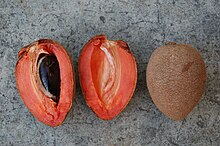Sapotaceae
This articleneeds additional citations forverification.(April 2013) |
| Sapotaceae | |
|---|---|

| |

| |
| Foliage and fruit (a berry containing one seed) ofPouteria sapota | |
| Scientific classification | |
| Kingdom: | Plantae |
| Clade: | Tracheophytes |
| Clade: | Angiosperms |
| Clade: | Eudicots |
| Clade: | Asterids |
| Order: | Ericales |
| Family: | Sapotaceae Juss.[1] |
| Type genus | |
| Manilkara Adans.[2]
| |
| Subfamilies | |

TheSapotaceaeare afamilyofflowering plantsbelonging to theorderEricales.The family includes about 800speciesofevergreentrees and shrubs in around 65 genera (35–75, depending on generic definition). Their distribution ispantropical.
Many species produce edible fruits, or white blood-sap that is used to cleanse dirt, organically and manually, while others have other economic uses. Species noted for their edible fruits includeManilkara(sapodilla),Chrysophyllum cainito(star-apple or golden leaf tree),Gambeya africanaandGambeya albida(star-apple), andPouteria(abiu,canistel,lúcuma,mamey sapote).Vitellaria paradoxa(shiin several languages of West Africa andkaritéin French; also anglicized asshea) is also the source of an oil-rich nut, the source of edibleshea butter,which is the major lipid source for many African ethnic groups and is also used in traditional and Western cosmetics and medications. The "miracle fruit"Synsepalum dulcificumis also placed in the Sapotaceae.
Trees of the genusPalaquium(gutta-percha) produce an importantlatexwith a wide variety of uses. The seeds of the treeArgania spinosaproduce an edibleoil,traditionally harvested inMorocco.
The family name is derived fromzapote,a Mexican vernacular name for one of the plants (in turn derived from theNahuatltzapotl) and Latinised byLinnaeusassapota,a name now treated as a synonym ofManilkara(also formerly known by the invalid nameAchras).
Genera
[edit]63 genera are currently accepted:[3]
- AbebaiaBaehni
- AmorphospermumF.Muell.
- AningeriaAubrév.&Pellegr.
- ArganiaRoem. & Schult.(also incl. inSideroxylon)
- AubregriniaHeine
- AulandraH.J.Lam
- AutranellaA.Chev.
- BaillonellaPierre
- BemangidiaL.Gaut.
- BrevieaAubrév. & Pellegr.
- BurckellaPierre
- CapurodendronAubrév.
- ChromolucumaDucke
- ChrysophyllumL.
- DelpydoraPierre
- DiploknemaPierre
- DiploonCronquist
- DonellaPierre exBaill.
- EberhardtiaLecomte
- EcclinusaMart.
- ElaeolumaBaill.
- EnglerophytumK.Krause
- FauchereaK.Krause
- GambeyaPierre
- GluemaAubrév. & Pellegr.
- InhambanellaDubard
- IsonandraWight
- LabourdonnaisiaBojer
- LabramiaA.DC.
- LecomtedoxaDubard
- LetestuaLecomte
- MadhucaBuch.-Ham. exJ.F.Gmel.
- MagodendronVink
- MalacanthaPierre
- ManilkaraAdans.
- Micropholis(Griseb.) Pierre
- MimusopsL.
- NeohemsleyaT.D.Penn.
- NeolemonnieraHeine
- NiemeyeraF.Muell.
- NorthiaHook.f.
- OmphalocarpumP.Beauv.
- PalaquiumBlanco
- PayenaA.DC.
- PichoniaPierre
- PlanchonellaPierre
- Pleioluma(Baill.) Baehni
- PouteriaAubl.
- PradosiaLiais
- PycnandraBenth.
- SahuliaSwenson
- SarcaulusRadlk.
- SarcospermaHook.f.
- SersalisiaR.Br.
- SideroxylonL.
- Spiniluma(Baill.) Aubrév.
- Synsepalum(A.DC.) Daniell
- TieghemellaPierre
- TridesmostemonEngl.
- TsebonaCapuron
- Van-royenaAubrév.
- VitellariaC.F.Gaertn.
- Vitellariopsis(Baill.) Dubard
- XantolisRaf.
References
[edit]- ^Angiosperm Phylogeny Group (2009)."An update of the Angiosperm Phylogeny Group classification for the orders and families of flowering plants: APG III".Botanical Journal of the Linnean Society.161(2): 105–121.doi:10.1111/j.1095-8339.2009.00996.x.hdl:10654/18083.
- ^"SapotaceaeJuss., nom. cons ".Germplasm Resources Information Network.United States Department of Agriculture.2003-01-17.Retrieved2009-04-06.
- ^Sapotaceae Juss.Plants of the World Online.Retrieved 6 June 2023.
